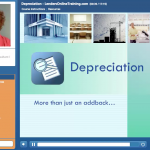Jenifer’s question:
We recently purchased new software that has a different approach to adding back depreciation on a 1065 return. In the past, I added back Line 16A (Depreciation including that reported on Form 1125-A and elsewhere). That said, some of our lenders added back Line 16C instead. Our new software instructs us to do something altogether different; start with the net income per books, add depreciation from line 16C, plus M-1 Line 4A, and then subtract depreciation from M-1 Line 7A. Was 16A or 16C right the old way? And why would the new method be suggested over what we have been doing?Linda’s answer:
Let’s start with taxable income and decide between adding back 16A or 16C. I generally add back 16A because that depreciation was subtracted somewhere on the return, often on Form 1125-A which is Cost of Goods Sold (COGS). And since COGS is subtracted on the top of the 1065, the depreciation reported there has been subtracted as well. Thus the inclination to add back the full amount, wherever it was deducted.Then there is timing…
So why would anyone see it differently? Well, it does add an element of timing into the mix. To the extent ending inventory is significantly higher at year-end than at the beginning, some of that depreciation is ‘sitting’ in the ending inventory. Unless it is a huge difference, though, I would not worry about the timing. I think you’ll generally be close enough if you use Line 16A. Apparently, you thought so, too.What if the software starts with net income per books?
Jenifer, these are two approaches that both work. Starting with taxable income, as you had been doing, only required that you add back depreciation that had impacted taxable income. Thus Line 16A. But with software that starts with net income per books, generally grabbed from Line 1 of the M-1, now you have to find and add back all of the depreciation that impacted that starting number, not taxable income.The three-step dance…
Now it takes three steps. You add back the depreciation that reduced taxable income and any depreciation on the books that did not hit the return. Then you reduce that by any depreciation on the return but not on the books. In other words, the second two steps are adjusting depreciation per tax return to depreciation per books.They both work!
That second approach works just as well, it just adds some steps. If I were queen for a day, I would stick with starting with taxable income for most small and mid-size businesses because I hate to add steps that do not make a difference. But for larger companies, having net income in mind instead of taxable might be worth the extra steps.More help with depreciation…
 Depreciation is one of the modules in our Credit Anaylsis Basics Course, one of three courses in Tax Return Analysis on www.LendersOnlineTraining.com.
You can take a free demo of five modules to try out the online training. Check it out.
Depreciation is one of the modules in our Credit Anaylsis Basics Course, one of three courses in Tax Return Analysis on www.LendersOnlineTraining.com.
You can take a free demo of five modules to try out the online training. Check it out.
